Power surges can damage household electrical appliances. To prevent this from happening, special devices are used - voltage stabilizers. They protect the power grid from interference, unstable power supply and provide devices with the necessary 220 V. Stabilizers are especially needed in a country house or cottage, since it is outside urban conditions that an unstable network is most often found. Stabilizers can be used both for simple household appliances (TV, refrigerator), and for devices with increased power.
Types of stabilizers
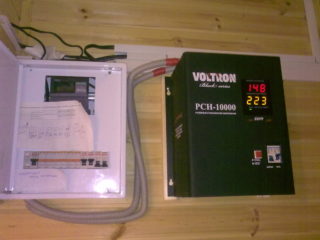
All voltage stabilizing devices can be divided into several categories:
- electromechanical;
- relay;
- magnetoelectric;
- pulse converters.
Switching of transformer windings in an electromechanical stabilizer is carried out using a motor. The slide block adjusts the applied voltage. The disadvantage of the system is its large size. Relay and magnetoelectric devices are also large-sized. This is due to the presence of a large voltage equalization transformer.
If you need a compact device, it is better to choose an impulse device. It is more expensive because there are special inverters in the design.
The choice of a specific model directly depends on the installation site and the financial capabilities of the user.
Switching stages
Any leveling device has switching stages. They determine the quality of the output electricity. At a normal voltage of 200 V, electricity is passed through the circuit unchanged. If the voltage drops (for example, to 190 V), the first stage turns on, at which the load is converted to the required 220 V. The lower the current voltage, the higher the stage the stabilizer will switch to. If all the steps are over, it will not be possible to raise the voltage.
Necessary materials
- Three-core cable VVG. Its cross-section must coincide with the cross-section of the lead-in cable on the switch or input circuit breaker.
- Three position switch for activating the stabilizer. It has 3 states - the first consumer is on, the second consumer is on, and off. Instead, you can use a conventional modular switch, but in this case, when disconnected from the stabilizer, the entire room will be de-energized each time.
- PUGV wires of different colors.
The stabilizer must be installed before the energy consumption meter. Any other connection is prohibited. This is due to the fact that the stabilizer has its own idle speed and consumes electricity. It should be taken into account when paying bills.
It is also recommended to put an RCD or differential machine in the circuit before connecting the stabilizer.
Choosing a location
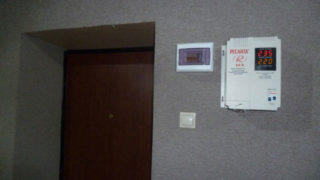
It is necessary to select in advance the place where the stabilizer will be installed. The dimensions of the device are determined by its output power. Small stabilizers can be placed next to the equipment on a table.Large models require permanent mounting. The installation site can be a floor, a wall or a pre-equipped niche.
Operating transformers heat up, which is why it is necessary to carry out a heat removal system. For this reason, the stabilizer should be installed in a location where the ventilation slots are accessible. Then the necessary air exchange will be created inside.
The installation site must be dust-free, free from humid air, away from flammable and combustible liquids. High temperatures, dust, moisture can damage the stabilizer. The optimal location is to install next to the junction box at the entrance to the meter.
Connection in the switchboard
After the machine, a three-position switch must be installed in the panel. In position 1, with the lever raised up, the voltage is supplied directly from the mains, without using a voltage stabilizer. This mode is used if the voltage regulator has broken down or if revision work is being carried out.
In position 2 with the lever pointing down, electricity flows through the stabilizer. In the zero position, all devices are disconnected from both the stabilizer and the mains.
Two VVG cables are laid from the panel to the selected installation site. For convenience, they need to be marked: input to the stabilizer and output. Part of the insulation is stripped from the cores and connected to the electrical panel. The phase from the input of the stabilizer goes to the output terminal to the difavtomat. The phase from the output goes to contact 2 on the three-position switch. Zeros and grounds from both wires are connected to the corresponding buses.
After the phase from the machine goes to the three-position switch. The assembly wire of the PUGV must be stripped from the insulating layer, terminated with a tip and turned on from the circuit breaker phase to the 4th terminal of the switch.
The last step is to power the machine from terminal 1 of the three-position device. This is also done with a flexible installation cable.
It is imperative to check the correspondence of the contacts in the documentation before connecting. They may differ from model to model.
Wire connection
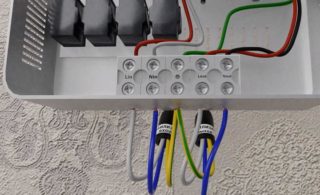
To connect, you need to remove the protective cover on the stabilizer. The input and output cables are threaded through the hole and clamped with clamps. The phase of the input cable must be connected to the input of the Lin. Zero to terminal N. Ground to appropriate terminal. If there is no earth, the core is screwed under the screw of the device case.
After energizing from the junction box, you need to supply the stabilized power back to the shield. To do this, you need to connect via the output cable from the stabilizer. Phase - to the Lout output, zero - to N, ground - to the same place where the grounding conductor from the input cable is connected.
The last step is to visually inspect the correct connection and test the system.
Features of connecting the stabilizer to a three-phase network
Three-phase stabilizers for each block have their own terminal blocks. When they are connected to the network, uniform distribution of single-phase consumers must be performed. This can be achieved by connecting to different blocks on the gimbal.
Typically, such circuits can be connected at manufacturing and industrial enterprises. This is due to the high cost of the device itself.
In domestic conditions, three-phase power consumers are connected through a single-phase device.
Checking the assembled circuit
The first activation is carried out without applying a load. Only the introductory machine is involved, the rest are turned off.
You need to start idling and see how everything works. The output and input parameters are checked, the absence of extraneous sounds and noises. It is recommended to look at what data is shown on the scoreboard.
If everything is correct, you can apply power.
Major mistakes
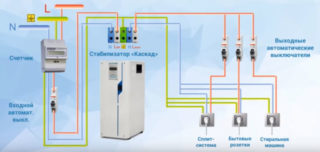
The most common connection errors include:
- Wrong choice of location. You can understand that the place has been chosen unsuccessfully by the overheating of the device, shutdown, and the appearance of erroneous information on the scoreboard.
- Using a conventional machine, not a three-position machine. Using a classic circuit breaker will not protect the device from damage. The voltage regulator must go from normal mode to "transit" with a certain sequence. First, the vending machines on the panel are turned off, then the switch is switched to the "transit" mode. Only after that the machines will be used again. If the sequence given is not followed, the switching will be carried out under load, which will cause the equipment to fail. When using a three-position switch, there is no need to memorize the algorithm.
- Incorrect connection of the voltage stabilizer for the house, the connection scheme is chosen incorrectly.
No lugs on stranded wires - Incorrect selection of the connection cable cross-section. A thinner wire is not able to withstand all the load passing through it, which leads to device breakdown.
- Not using tips. All wires must be crimped, even when connecting low amperage devices.
- Problems with machines in the dashboard. Even if the device is properly connected and the device is in good working order, knocks may occur. It can be caused by a low supply voltage (for example, 150-160 V with the required 220-230 V).
When installing the device, you need to take into account all the nuances and not make the listed mistakes.

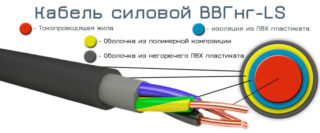
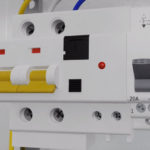
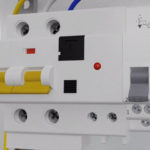









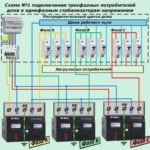
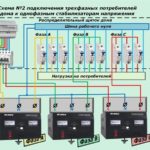
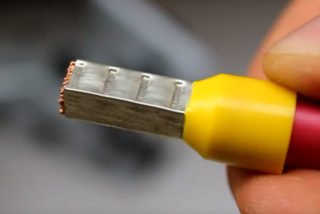








This circuit, in my opinion, is bad in that if the stabilizer is removed, the wire (input stabilizer) will be energized all the time.